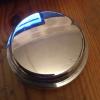Excellent that means I don't have to draw anything!
No there is no description of the root of Unified threads in the stanadard, that's because they were originally flat bottomed as well as flat topped. That made them very weak. They were invented in 18 something or other though at the dawn of standardisation and industry in America and at the time people didn't know that a radius would be stronger (although Whitworth already had radii in his thread at this time). As cutting tools wore out the threads produced developed a radius and people noticed the radiused thread was stronger. For details of a standard for the root radius look up UNJF or UNJC, these are aeropsoace threads. I don't know whether people apply this specification to regular UN fittings now or not but there is at least a standard there.
As for WF, I'm never going to accept that there is a Whitworth Fine. Whitworth was the first and original standard thread, the first one ever. Before Joseph Whitworth threads were custom made for every machine or fitting and nothing was interchangeable. When the thread was adopted as BSW it should have become BSC but didn't out of respect for the man and for history. There was never a fine thread devised by Whitworth, he created one singl thread and specified it from 0.1" 48 tpi to 6" 2.5 tpi. All the derivitives of his thread were made later by others and so have BS names. There are many besides BSW and BSF including BSCy, BSB, BSP, BSPT and others but none of them has 16 tpi at 5/8". This is a custom thread, plain and simple. It may appear in other parts of various Austin engines and they may have originally designed it but it is not on any standards tables. People in other countries may refer to BSF as Whitworth but they are not right. This tap may have had WF stamped on it by a Chinese machine shop but they aren't right either. Then again, WF could be the name of whoever made it.
A "J" type UN thread form is what is known as a "controlled" root radius not specifically for Aerospace use as you will find them on your Mini, but thats another topic........ Controlled root radii are simply that the root radii has a tolerance that is controlled and therefore between certain limits.
Edited by mra-minis.co.uk, 30 March 2009 - 11:22 PM.


















